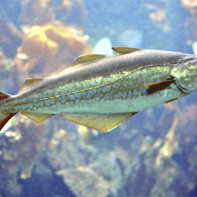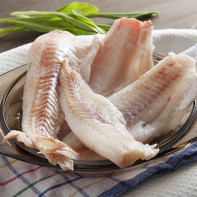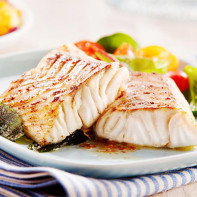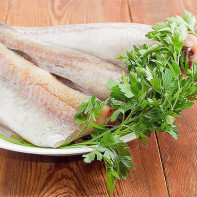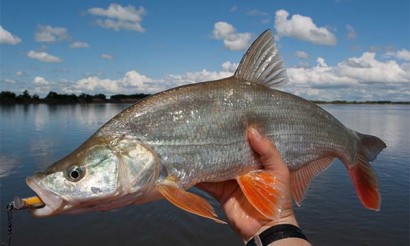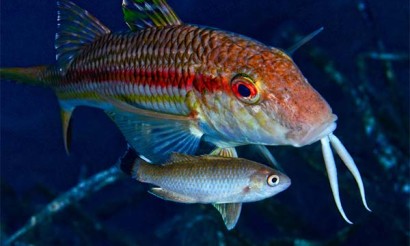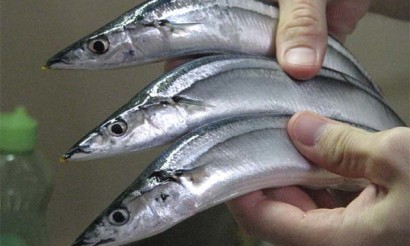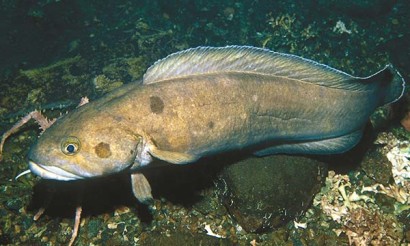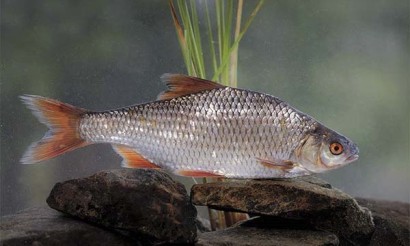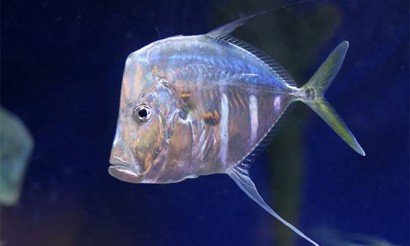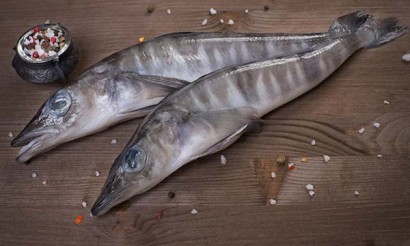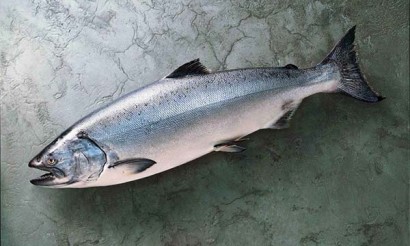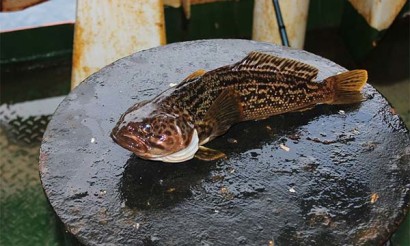Pollack fish: photo, description, useful properties and recipes
Pollack is one of the most useful varieties of fish. Many people think that since it costs cheaper than, for example, pikeperch, then it is worse in its nutritional qualities. But in fact it is not so. You just need to choose a quality fish and cook it according to a proven recipe.
- Pollack: what kind of fish, how it looks and where it is found
- What is the difference between pollock and cod and hake
- Composition and calories
- Useful properties of pollock fish
- General benefits
- For Women
- For Men
- In Pregnancy
- Breastfeeding
- For children
- For weight loss
- What is useful for Pollack caviar
- The use and harm of Pollack liver
- Can we eat pollock for different diseases
- Diabetes mellitus
- Pancreatitis
- Gastritis
- For gout
- Hazards and contraindications
- How to choose and store
- How to clean Pollock fish
- How to cook pollock very well: Recipes
- In the oven
- In a frying pan
- In a multicooker
- In the steam cooker
- On the grill
- On the grill
- What can be made of Pollock: Recipes
- Cutlets
- Soup
- Salad
- Casserole
- Canned
- Can I Give Alaska Pollock to Dogs
- Interesting facts
Pollack: what kind of fish, what it looks like and where it lives
Pollack is a fish of the Cod family. Its body length reaches 90 cm (although on the shelves more often there are examples of length only 80 cm). Weight of a single fish up to 5 kg, although on sale again, it is easier to find instances of up to 2.5 kg. In the wild the pollock lives long enough - up to 15 years, but it reaches its maximum weight at the age of 3-4 years. This is the time of sexual maturity, when the pollock begins to approach the coast for spawning.
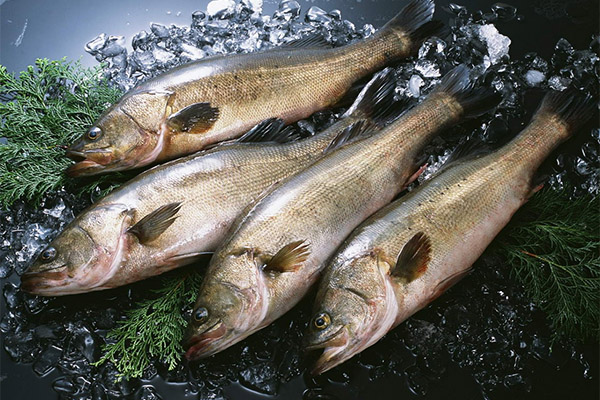
In different parts of the world's oceans spawning can occur at different times, which affects the time of catching fish. For example, in the Bering Sea it lasts all spring and summer until early September, while off Kamchatka it only lasts in spring. Females have the ability to lay eggs even at low temperatures. At the same time, pollack caviar is considered a delicacy.
Pollack has a distinctive appearance that makes it relatively easy to "recognize" it among other species. The most striking external features include the presence of three dorsal fins, a short antenna located under the lower lip, big eyes and spotted coloration.
In the wild, walleye pollock prefer cold waters. And of all the cod fish in the world's oceans, the pollock accounts for the largest catches. It used to be about 7 million tons, and the Soviet Union was the leader in this industry. Pollock is found not only in the Sea of Japan, but also in the Bering Sea, Barents Sea, and Sea of Okhotsk, and to a much lesser extent - in the ocean waters and the Gulf of Alaska.
Pollock catches in general have now declined as it has lost some of its popularity - at least as a stand-alone dish. At the same time, it is a raw material for the production of surimi, from which crab sticks are made in China and Korea.
However, scientists and economists believe that the role of the pollock in the food security of the country should not be underestimated, so Russia is trying at least to restore the volume of catches to previous indicators.
What is the difference between pollock and cod and hake?
Pollack, cod и hake - are different species of marine fish, although they belong to the same Cod family. Of all the listed varieties, pollock is considered to be the most affordable. As for the caloric content, the difference between them is insignificant. However, hake has slightly lower calories than pollack. However, the fillet of this fish is considered more tasty and less dry than that of the pollack (because the latter has the main amount of fatty acids concentrated in the liver).
As for the external differences, they are more pronounced. For example, hake is usually longer and has a more elongated shape. In addition, hake has only two dorsal fins and no tendril under the lip.
Cod is larger (some specimens may be as long as 2 m) and darker in color.
Composition and calories
Alaska pollack is considered one of the most useful varieties of marine fish, because it has low fat content. It contains 16 g of protein and only 1 g of fat per 100 g. At the same time, another advantage is its low energy value - only 70 kcal in 100 g of pollock fillets.
The taste of this fish is neutral, and so is its smell. White meat contains few bones, and therefore it is easier to cook it for children.
In terms of chemical composition, the most valuable part of the pollack is its liver. It contains a lot of vitamin A, much more than in the composition of the liver of cod. Vitamin A is very important for good vision, it is also an antioxidant, has anti-inflammatory properties and promotes cell renewal.
As for the pollock fillet itself, in addition to protein, it contains mainly various vitamins and minerals. Of the vitamins, the most important role is played by B9, in other words - folic acid. It is especially useful for expectant mothers for the normal development of the child's nervous system.
Another important vitamin - PP, and it contains a lot of it compared with other varieties of marine fish - up to 4.6 mg per 100 grams of product. It strengthens blood vessels, promotes accelerated lipid metabolism, reduces "bad" cholesterol, provides the synthesis of red blood cells and hemoglobin.
Pollack fillets also contain vitamin A and ascorbic acid, which has a beneficial effect on the circulatory system and also has antioxidant properties.
As for minerals, it contains the most:
- Potassium, essential for the cardiovascular system.
- Phosphorus, which strengthens bones and is useful for cognitive function.
- Iodine, which is also necessary for improving memory and brain function, and the prevention of some thyroid pathologies.
- Calcium, which improves dental and nail health.
- Zinc with its anti-inflammatory properties.
- Iron, which protects against anemia and is involved in the process of hematopoiesis.
Pollack fillet also contains sulfur, magnesium, fluorine and other beneficial substances.
Useful properties of pollock fish
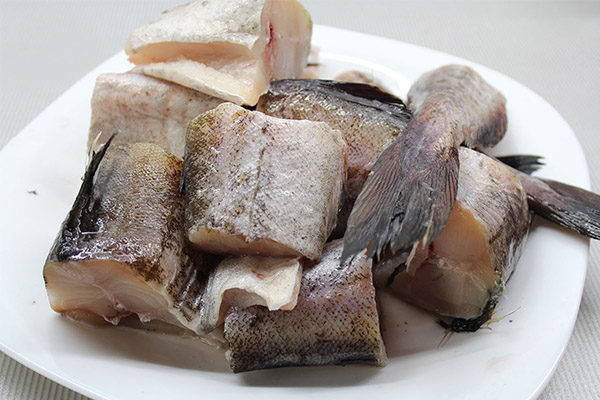
General benefits
Pollack contains many useful substances, so the use of this variety of fish is recommended:
- to strengthen the immune system;
- increasing the elasticity of blood vessels and reducing cholesterol levels;
- excretion of toxins from the body;
- maintaining the function of the liver, cardiovascular system and other internal organs;
- slowing the aging process;
- Improve memory and cognitive function;
- reducing the risk of inflammatory diseases and the formation of malignant tumors.
And, of course, the regular consumption of pollock helps to strengthen teeth and bones, which is important not only for women during pregnancy, but also during menopause.
For women
For the fair sex, pollock is useful for several reasons. First, it contains omega-3 fatty acids and vitamins that allow normalization of hormonal levels. This is important not only because it allows the treatment of amenorrhea, but also because it has a generally beneficial effect on the reproductive system.
For men
For the stronger sex, the consumption of pollock is important in terms of getting a lot of protein - it is also necessary for those who are engaged in heavy physical labor or engaged in the gym. In addition, including pollock in the diet will significantly reduce the level of "bad" cholesterol and reduce the risk of atherosclerosis, which many men face today (and this disease, unfortunately, is "getting younger" every year).
Finally, high levels of zinc and iodine can ensure the normal functioning of the reproductive system, reduces the likelihood of inflammatory prostate diseases.
During pregnancy
It is believed that pollock is very useful for mothers-to-be. First, because it contains a lot of protein, which is the building material for the baby's body. Secondly, it has a low caloric value, which helps to keep the weight within the norm.
Finally, mint contains omega-3 fatty acids, which contribute to a healthy nurturing baby, the proper development of its nervous system - along with B vitamins, also contained in this product.
When breastfeeding
It is very important for young mothers to get in shape after childbirth, but also to establish lactation, that is, without strict diets, which could damage the baby, who does not receive enough useful substances with mother's milk. From this point of view pollock is an ideal product. It is a low-fat kind of fish, which will help to get rid of extra pounds and at the same time provide protein and vitamins. And a young mother can include it in her diet as early as 2-3 weeks after childbirth, when the baby's digestive system is strong enough to try something new, coming with milk.
For kids
Alaska pollack is a low-fat variety, while it contains a lot of protein and B vitamins, so that children it is very useful for normal physical and mental development. Babies can be introduced it in the complementary food even when the child is 8 months old. To start boiled fish is better added to vegetable soup, mashed in a blender to puree. Later, you can give your child steamed cutlets.
For weight loss
Alaska pollack is a lean fish. It has a low energy value, but at the same time it contains as much protein as meat. So it is ideal for those who are on a diet and want to get rid of extra pounds in the most healthy way.
If you include pollock fillets in your diet, you can even actively engage in sports, which is not always possible with strict diets. Specialists have even developed a special diet based on pollock. Her ration looks like this:
- For breakfast - a piece of boiled fillet of pollock weighing up to 150 g, a glass of mineral water without gas.
- For lunch - a vegetable soup (for example, beet soup) without any additives, including without sour cream, a plate of salad with leafy greens and carrots.
- For dinner, you can have a fish cutlet (preferably steamed), two baked potatoes, and a cup of green tea.
In general, it should be noted that fish and coffee are not combined for many reasons. To get your energy supply during such a strict diet, it is better to drink green tea without sugar.
In just a week after starting a fish diet, you can notice that thanks to the amino acids and antioxidants contained in the pollock not only lose extra pounds, but also smooth out fine wrinkles, significantly improve the condition of hair and nails.
What is useful for pollock caviar?
Pollack caviar is a high-protein delicacy. It also has low fat content and contains many B vitamins, sulfur, phosphorus and copper. This product is particularly useful for improving cardiac function. Also, caviar is full of vitamins A and E, which are considered antioxidants, have anti-inflammatory properties and help slow down the natural aging process.
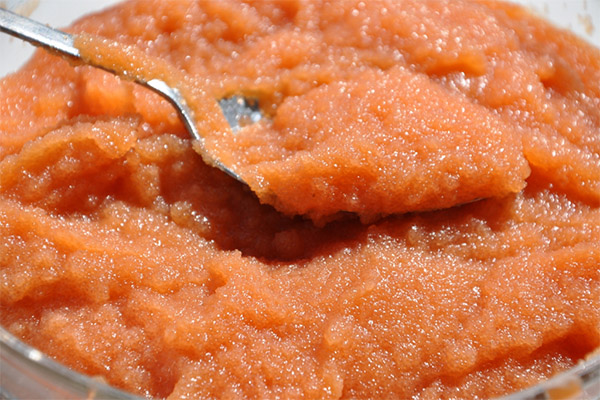
But for all its beneficial properties, pollack caviar can be harmful to humans - provided that the daily norm of its consumption is exceeded. The fact is that pollock caviar contains chlorine and sodium, and in large quantities. In 50 g of caviar their amount is noticeably higher than the daily norm of consumption, so 25 g of caviar per day is an objective maximum. In addition, it is advisable not to buy ready-made caviar, but to salt it yourself - so there will be much less sodium chloride than in a factory product.
The benefits and harms of Pollock liver
Pollack liver is considered a delicacy product. It is popular in Europe, especially appreciated in French cuisine. Indeed, when properly cooked, pollock liver can be very tasty, but more importantly - useful. Its caloric value is higher than that of the fillet: it has about 474 kcal per 100 g.
At the same time, it contains a lot of vitamins. First of all, it is vitamin D, as well as tocopherol and group B. In addition, it contains copper, iron and the aforementioned omega-3 fatty acids, and even in a higher concentration than in the fillet itself. All these substances make this product useful for thyroid health, strengthening bones and teeth, normalizing metabolic processes, maintaining cardiac activity. In addition, the use of pollock liver on a regular basis can significantly improve vision and stop age-related deterioration, as this product also contains a large amount of vitamin A.
At the same time, there are no special contraindications for pollock liver. It should not be consumed only in the presence of an allergy to fish.
Can I eat pollock for various diseases
Pollock is considered one of the best options for dietary nutrition. But for each disease in this case, there are different peculiarities.
In case of diabetes
In this disease, it is very important to achieve a reduction in excess weight. And from this point of view, pollock is one of the most useful varieties of fish. It can and should be eaten with diabetes.
Moreover, products with high protein content are very useful for this disease, and pollock is just the same, especially since it also contains omega-3 fatty acids, which makes this kind of fish an ideal option. Its use allows not only to get rid of extra pounds, but also to cope with neuropathologies and cognitive disorders arising from diabetes. Niacin contained in mint helps to regulate blood sugar levels.
Important: The glycemic index of pollock is 0 units.
In pancreatitis
In acute pancreatitis (or exacerbation of chronic disease) a therapeutic fasting is prescribed, so no fish is included in the diet at this time. However, with chronic pancreatitis in remission, pollock can and even should be included in the menu. Broths from it, of course, do not boil, but a piece of boiled or baked fish will even be useful, given the anti-inflammatory properties of the ingredients included in the fillet.
With gastritis
In the acute form of gastritis, it is not recommended to consume pollock. But with a chronic form, it will even be useful. The fact is that the protein of this variety of fish is very easily digested, its processing does not require a large amount of gastric juice, so for the inflamed mucous membrane - this is an excellent dish (but only in a boiled or baked without crusting). In fact, the substances contained in the pollock fillet even contribute to the regeneration of these tissues. Caviar or liver of this fish for gastritis is better not to eat. Caviar contains too much salt, while liver is considered too fatty, so the best choice is a fillet of this fish.
In case of gout
In this disease, you should not eat foods that contain a lot of purines. In mint they are present in small amounts. At the same time, its fillets contain substances with anti-inflammatory properties, so in many ways they can improve the situation and in joint diseases, including gout.
Harms and contraindications
Unlike other types of marine fish, pollock causes almost no allergies, but still in the presence of appropriate reactions to other seafood it should also be used with caution. Also, people suffering from hypertension should not be fond of it, because it itself contains quite a lot of sodium salts.
It is important to choose the right pollock. Very often other species are passed off as this fish. Pollack feeds on plankton, so it is healthy. Bottom species often eat what people would call trash, so there is a high risk of poisoning. One should only buy products from manufacturers who can provide a certificate. It is interesting that most Russian companies sell quite large carcasses of pollock, but there is nothing wrong with that - it's just that domestic legislation prohibits the catch of young fish. Japanese products are not represented in the Russian market, but there is a Chinese one.
How to choose and store
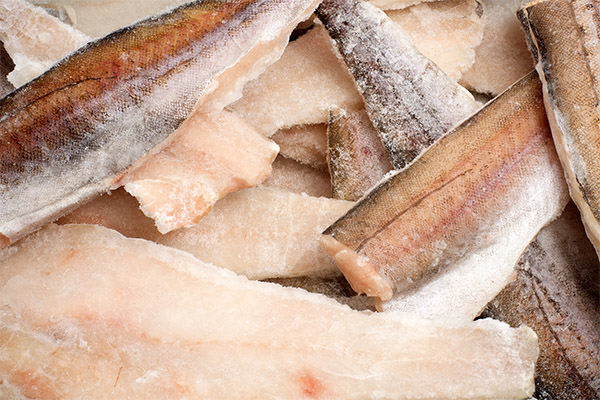
It is very important to choose the right pollock fillet. Most often it is sold in frozen form, but there is still something to consider. Be sure to pay attention to the color of the fish surface. It should remain a light shade, no spots, except natural, on it should not be, dried out areas too. Such defects indicate that the conditions of storage were not respected. In addition, the layer of ice on the surface should not be too thick, it only indicates that the fish has long been in the refrigerator. And it makes no sense to overpay for the weight of the ice.
Theoretically, frozen mint should have nothing but fish and water (i.e. ice). But some manufacturers add polyphosphate E452. In principle, it is not dangerous to health, but the European legislation prohibits this additive. Its main purpose is to retain moisture not only outside but also inside the carcasses, which means that when it is used, the fish remains more juicy.
Thick scars that appear on uncut fish indicate that even if its shelf life is not yet up to date, it still has withstood several defrosting and freezing. It is better to refuse such a purchase.
Frozen pollock should be stored in the freezer at the temperature of -18 degrees, without allowing its fluctuations, otherwise the surface of the fish will have an unpleasant gray hue and the corresponding smell will appear. The shelf life of pollock is limited; it should be indicated on the store package.
It is necessary to defrost pollack in the refrigerator, having transferred it from the freezing chamber to a usual one. It is better to do it overnight. It is not necessary to defrost pollack in hot water or microwave, it can worsen the taste of fish.
How to clean pollock fish
After defrosting, the fillet should be washed properly, and then proceed directly to cooking, if it has already been cut.
If it is a whole fish, then first you need to rid it of scales. The difficulty is that its scales are small and not always well visible. Ideally, it is best to use a special knife for this purpose, but you can simply go over the surface gently with a stiff dishwashing sponge, acting so as not to damage the thin skin.
As for the further cutting, it is necessary first to cut the head of the fish, then cut the stomach and remove the insides, and then get rid of the fins. The last action is performed using kitchen shears. Especially carefully you need to choose bones from the fillet, because the meat is tender, can easily disintegrate into pieces.
How to cook pollock deliciously: recipes
Almost all nutritionists recommend either baking pollock in the oven, or boiling it, or making steam cutlets. You can from time to time include in the diet and fried pollock - if not too keen on oil when cooking it. Pollack is also used to make fillings for traditional Russian pies. Since this fish is inexpensive, it is very popular with many generations of housewives, including - as the easiest way to combat iodine deficiency, from which almost all city dwellers are suffering today.

In the oven
Pollack can be baked with apples and spices. For 0.5 kg of filet of this fish you will need 2 sour-sweetened large apples, 1 large onion, 10 ml of classic soy sauce, 1 medium-sized carrot, 20 ml of olive oil, salt to taste. As a spice, you can use a mixture of ginger powder, freshly ground black pepper and coriander.
Fillet of pollock washed and dried with paper towels, sprinkle with a mixture of spices and soy sauce and leave in the kitchen for half an hour without putting it in the fridge. Meanwhile, cut the onion into half rings and fry in a well heated frying pan until translucent. Then add coarsely grated carrots and blanch all together for 5-6 minutes, then turn off the fire under the pan.
Apples are washed, peeled, cut out the core, and grate the rest, add to the vegetables in the pan and mix.
On a sheet of foil lay out half of the vegetable mixture, distributing it evenly, then the pollock fillets - the portions should lie closely together. On top of them cover with another layer of vegetable mixture, and wrap the foil in an envelope, put it on a baking tray and bake the dish in the oven for 25 minutes at maximum temperature.
In a pan
For 0.4 kg of pollock fillets take 2-3 small onions, 3 tablespoons mayonnaise, flour for breading, salt, spice mixture and oil to taste. Cut thawed, washed and dried pollock fillets into portions crosswise, cut the onions into half rings. Sprinkle pieces of fillet on all sides with spices and at the same time put a heated frying pan with vegetable oil. Each piece of fillet is first dipped in mayonnaise, then breaded in flour with a little salt (note that the fish itself is salty and so is the mayonnaise).
Then put the pollack pieces prepared this way on a heated frying pan, put the onions between them and fry all together for 7-8 minutes. Then turn the fish with a spatula with the other side up, gently mix the onions and fry for 7 minutes more.
In multicooker
For 0.5 kg of Pollock fillets take 1 large red onion, two medium-sized carrots, 250g of fresh or canned tomatoes, 2 tablespoons of olive oil and 1 tablespoon of granulated sugar, spices and salt to taste. Wash the pollock fillet under running water and cut into portions. Wash the onions and carrots, peel and cut into slices. If the tomatoes are fresh, it is recommended to boil them to remove the skin and grind them in a blender. Tinned tomatoes are rubbed together with the juice through a sieve or also grind in a blender.
In the bowl of a multicooker put half of the prepared fillets, then half of the total amount of onions and carrots, then another layer of fish and a layer of vegetables. In the tomato puree add salt, sugar, spices and vegetable oil, stir and pour the fish with this mixture. Cook in "Multivapor" mode for 15 minutes.
In the steamer
For cooking in a steamer for 0.4 kg of pollock fillets take a mixture of spices for fish, 1 tbsp freshly squeezed lemon juice, a bunch of dill, salt to taste. Thaw the filet, rinse, cut it into pieces. Each of these pieces sprinkle with spices and pour lemon juice, and then leave for 10-15 minutes. Then put the pollock in a bowl of a steamer, add a sprig of dill and cook for 20-30 minutes (depending on the size of the pieces and the power of the device). Before serving, discard the dill, it is only needed for flavor.
On the grill
For 400g of Pollock fillets take 4 tablespoons of classic soy sauce, 3 tablespoons of mayonnaise, herbs, salt and spices to taste. Make a marinade of soy sauce, mayonnaise and spices. Dip the slices of pollock in the marinade and put it in the fridge for 2 hours, you can wait even longer. The prepared fish is put on a greased grill and fry over hot coals until tender.
Mayonnaise in this recipe if you want you can replace sour cream or kefir or add lemon juice.
On the grill
Cook pollock in this case is about the same as on the grill. But for the barbecue, it is more often selected a company - for example, it can be shrimp, and if a person does not follow a diet - even bacon. The marinade is made with olive oil, lemon juice and zest.
What can be cooked from pollock: Recipes
From pollock you can make many delicious and healthy dishes - not only soup and cutlets, but even a salad.
Cutlets
From pollock fillets, you can prepare tender cutlets. For this, for 0.5 kg of fish take 1/2 cup milk, 2 medium-sized onions, 100 grams of wheat bread, 1 chicken egg, 5 tablespoons of flour, vegetable oil, salt and pepper to taste.
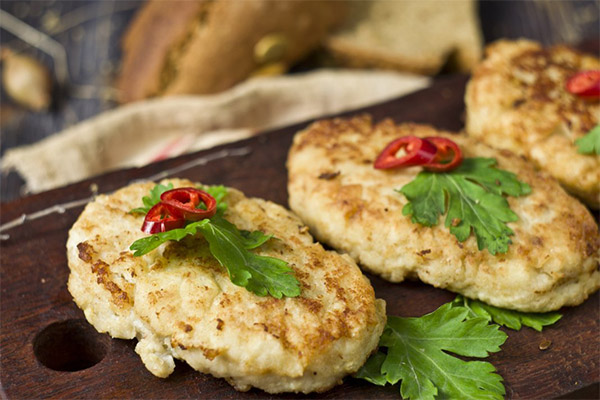
Chop the fish fillet with a food processor or blender. Pre-soak the bread in milk. Finely chop onions, mix with minced fish, eggs and well-pressed bread crumbs. Then add salt and pepper to this mixture and chill in the fridge for some time. Then make cutlets from the force-meat, roll them in a little flour and fry in vegetable oil on each side for 10 minutes.
Soup
For 2 fillets weighing 400 g take 2-3 potatoes, 1 carrot, 1 bell bell pepper, 1 tablespoon of rice grits, 1 onion, spices and salt to taste, 2 tablespoons of olive oil. Wash and peel the vegetables, cut them into small pieces. First boil the potatoes and rice for 10 minutes until half-cooked. Then add chopped pollack fillets into a saucepan and boil for 10 minutes more. Meanwhile, in vegetable oil lightly fry the onion with carrots and bell peppers, this will take about 10 minutes. Add vegetable medley to rice, potatoes and fish and cook for 10 minutes more. Serve to the table, sprinkling chopped fresh herbs.
Salad
Mint is perfect for a flaky salad. For 0.4 kg of fish fillet take 2-3 large potatoes, 2-3 eggs, 1 large onion, a bunch of dill. Bottom layer - boiled and finely chopped pollock fillets, the second - diced boiled potatoes, then finely chopped onion, chopped whites and grated yolks. Spread each layer with mayonnaise.
Casserole
In fact, this is the same pie with fish filling, just somewhat modern. To make it you should take 0.6 kg of pollack filet, ¾ of a wheat loaf, 200 ml of milk, 1 large onion, 2 medium-sized carrots, 3 potatoes, a small bunch of dill and a couple of sprigs of herbs, combined with fish, 2 tablespoons of olive oil, freshly ground black pepper and salt to taste.
Wash the root vegetables thoroughly with a brush and boil them in jacket so they don't fall apart. When they have cooled, both carrots and potatoes are peeled and grated on a coarse grater. The greens are washed, dried and finely chopped. Shred the onions finely, too, and fry them in vegetable oil for 5 minutes, then mix them with the prepared vegetables and herbs.
Grease a baking dish, lay a layer of vegetables on the bottom, top with the fish filling, chopped in a blender into minced meat, and the remaining vegetables. Cover the casserole with a sheet of foil and place it in the heated oven, where it will cook for 35 minutes. Then remove the foil, brush the top with a beaten egg and put it in the oven for another 7-10 minutes. The advantage of this dish is that it will be equally delicious both cold and hot. In addition, it can be modified by adding mushrooms in the stuffing there.
Canned
For 2 kg of pollock, take a glass of vegetable oil, 1 tbsp. salt, a bay leaf and a mix of peppers to taste. Prepare the fish beforehand, wash and cut into portions. In sterilized jars place the bay leaf and pepper mixture. Place pieces of fish, mixed with vegetable oil and salt. Cover the jars with lids, put in a large container filled with water and cook over low heat for 4 hours. Then seal the jars.
Can I give Pollack to my dog?
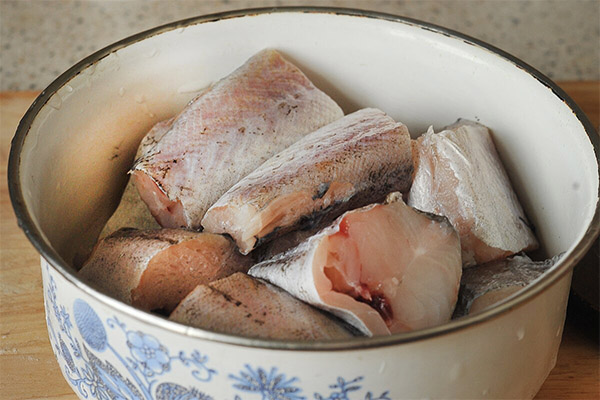
From time to time you can add pollock to the pet's diet, but it should be a delicacy, not an everyday treat. One should only give it if the owner is sure that the pet is not allergic to this fish. But in general, it is recommended to offer dogs more fatty varieties (hake or cod).
Interesting facts
Alaska pollack is a very interesting fish in terms of its chemical composition. For example, it contains such a relatively rare element, such as cobalt. The unique combination of all the listed components allows not only to normalize the weight, but also to reduce blood sugar levels. And there is scientific evidence that with regular consumption of pollock, the skin stops peeling, gets a healthy shade, and the condition of the hair significantly improves.
Nutritionists consider brown rice and non-starchy vegetables such as broccoli the best side dish for pollock. It can be added to the casserole with fish filling - and the dish will look even dressed up.
«Important: All information on this site is provided for informational purposes only for your own information. Check with your health care professional before using any of the recommendations. specialist before applying any of the recommendations. Neither the editors nor the authors shall be liable for any possible harm caused by materials."

